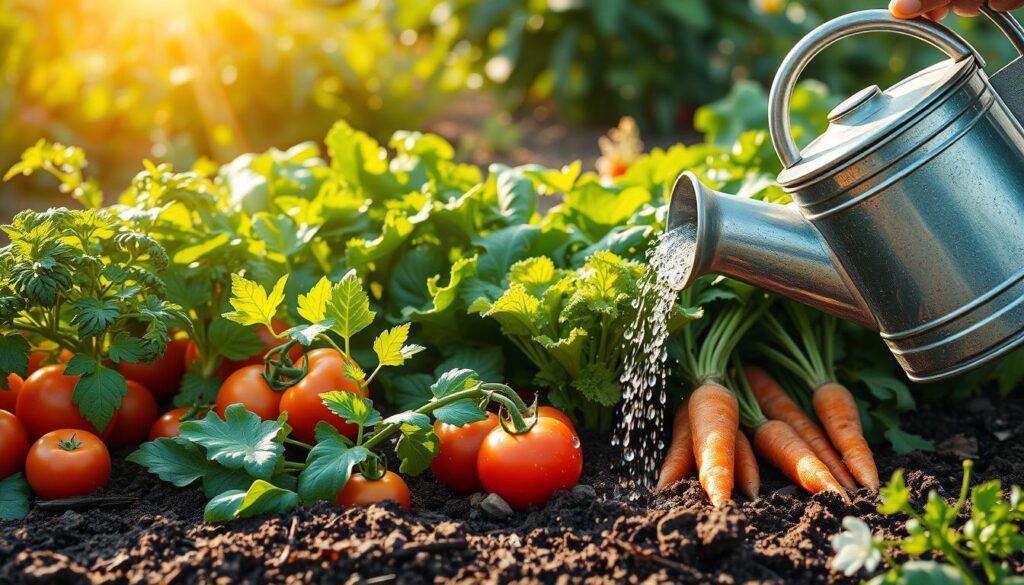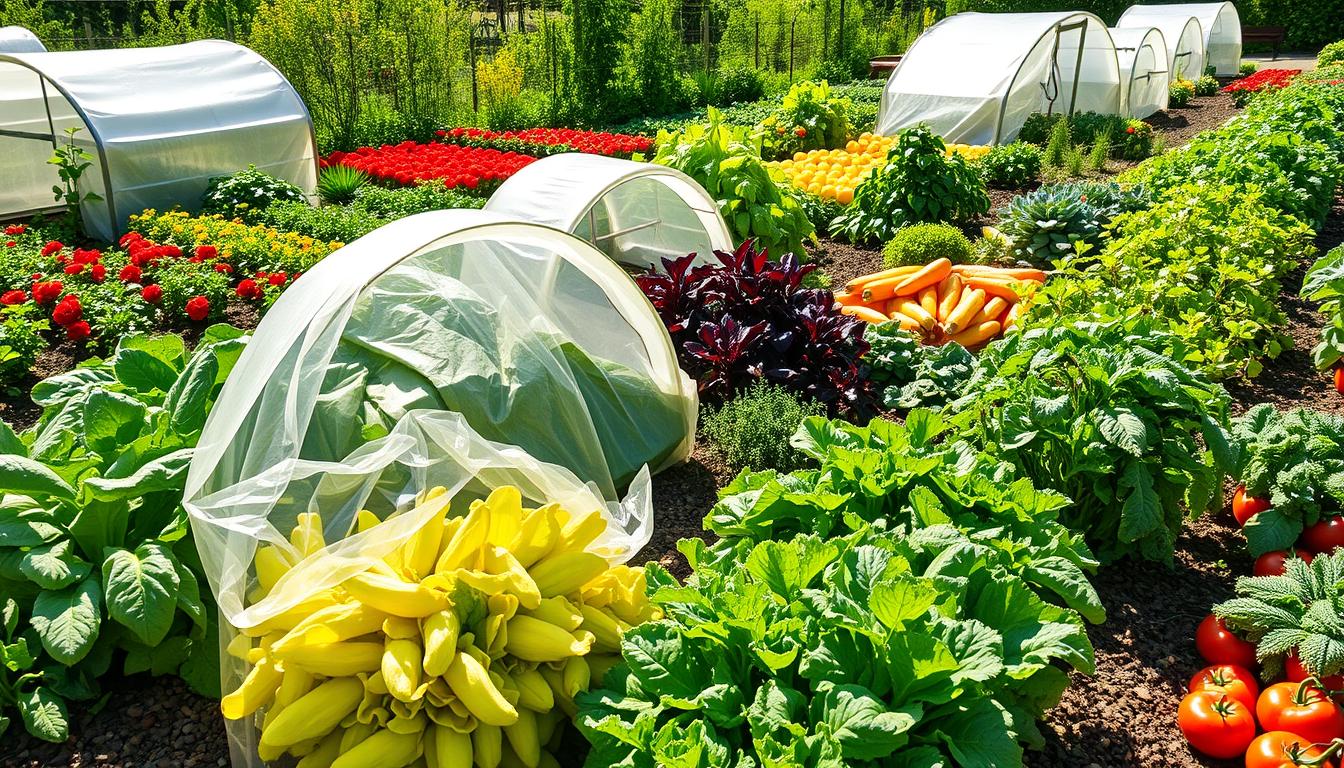In this article, I’ll show you how to plan a vegetable garden for a continuous harvest. You’ll learn about your growing season, pick the best vegetables, and design a layout. You’ll also discover gardening techniques to make your garden productive all year.

Key Takeaways
- Understand your local growing season and hardiness zone to plan a successful vegetable garden.
- Select a variety of vegetables that will thrive in your climate and provide a continuous harvest.
- Design an efficient garden layout using crop rotation and companion planting techniques.
- Implement succession planting and season extenders to extend your growing season.
- Maintain soil fertility and use water-efficient strategies for a thriving garden.
How to Plan a Vegetable Garden for Continuous Harvesting
Creating a vegetable garden for continuous harvests needs careful planning. You must know your local growing conditions well. With a few key techniques, you can have fresh produce all year.
Start by learning about your hardiness zone and frost dates. This helps pick the right vegetables and plan when to plant. Knowing your growing season is the first step.
Next, choose the right vegetables for your garden. A good layout and crop rotation are key to high yields. Companion planting helps keep pests away and promotes healthy plants.
Succession planting, using season extenders, and intensive gardening boost your garden’s productivity. These methods ensure a steady supply of fresh vegetables.
Keeping your soil fertile with compost and mulch is crucial. Drip irrigation is a smart way to water your plants efficiently. This saves water and keeps your plants healthy.
By following these vegetable garden planning tips, you’ll have a year-round garden. Your table will always be filled with fresh, homegrown food thanks to continuous harvest strategies.
| Technique | Benefits |
|---|---|
| Crop Rotation | Helps prevent pest and disease buildup, maintains soil fertility |
| Companion Planting | Enhances plant growth, deters pests, and promotes biodiversity |
| Succession Planting | Ensures a continuous supply of fresh produce throughout the season |
Understand Your Growing Season
Before starting your vegetable garden, it’s key to know your local growing conditions. This info helps pick the right plants and plan your planting schedule.
Determine Your Hardiness Zone
Finding your USDA hardiness zone is the first step. It’s based on your area’s average winter temperature. Knowing this helps choose plants that will grow well in your climate. It ensures your vegetables will thrive and give you a great harvest.
Calculate the Frost Dates
Knowing your hardiness zone isn’t enough. You also need to find your area’s frost dates. These dates are crucial for planning when to plant and transplant. They help you avoid cold damage and extend your growing season.
With your hardiness zone and frost dates in hand, you’re ready to plan a garden. It will give you a steady supply of fresh vegetables all season long.
| Location | Hardiness Zone | Average Last Frost Date | Average First Frost Date |
|---|---|---|---|
| New York, NY | 7a | April 15 | October 31 |
| Seattle, WA | 8b | April 1 | November 15 |
| Miami, FL | 10b | No last frost | No first frost |
Choose Suitable Vegetables
When planning a vegetable garden for continuous harvesting, it’s key to pick a variety of crops. This ensures a steady supply of fresh produce all year. By choosing vegetables with different maturity times, you can enjoy a consistent harvest.
To create a bountiful continuous harvest, consider these guidelines when selecting your vegetables:
- Fast-Growing Vegetables: Include quick-maturing crops like lettuce, radishes, and spinach. These can be grown in successive plantings for a steady supply.
- Cool-Season Crops: Incorporate cool-weather-loving veggies such as broccoli, cauliflower, and kale. These thrive in the spring and fall.
- Heat-Loving Plants: Balance your garden with warm-season crops like tomatoes, peppers, and eggplants. These flourish during the summer months.
By carefully selecting a diverse range of vegetable selection, continuous harvest crops, and season-specific produce, you can create a bountiful and continuous harvest in your vegetable garden throughout the year.
“Variety is the spice of life, and the same holds true for a successful continuous harvest vegetable garden.”
Remember, the key to a thriving continuous harvest is to choose a well-rounded selection of vegetables. This will provide a consistent supply of fresh, nutritious produce from spring to fall.
Design Your Garden Layout
Organizing your vegetable garden layout is key for a continuous harvest. A good design maximizes space and ensures a rich crop. We’ll look at two important strategies: crop rotation and companion planting.
Implement Crop Rotation
Crop rotation is vital for sustainable gardening. It prevents pests and diseases and keeps the soil healthy. A good plan boosts your garden’s health and productivity.
- Move your crops to different spots each year. This stops pests and diseases from building up.
- Group plants by their needs and growth habits. This makes the most of your space.
- Alternate between heavy and light feeders, and nitrogen-fixing crops. This keeps the soil balanced.
Consider Companion Planting
Companion planting is also crucial. It involves placing certain plants together for mutual benefit. This can help both plants grow better.
- Pair plants that complement each other. This can include deterring pests or attracting beneficial insects.
- Try different companion planting combinations. See how plants interact naturally.
- Plan your crop rotation and companion planting for a beautiful and efficient garden layout.
With a well-designed garden, you can make the most of your space. Enjoy a continuous harvest all season long.
| Crop Rotation | Companion Planting |
|---|---|
| Prevents pest and disease buildup | Enhances pest and disease prevention |
| Maintains soil fertility | Improves plant growth and yields |
| Optimizes use of garden space | Creates a visually appealing garden design |
Master Succession Planting
To grow a lot of vegetables, you need a good plan. Succession planting is a smart way to do this. It lets you keep picking fresh veggies all season long. By planting the same crop at different times, you get a steady flow of food.
Start Seeds Indoors
Starting seeds indoors is a great first step. It gives your plants a head start. This way, you can plan your planting better and make sure your plants are strong before they go outside.
For seed starting and indoor seed germination, you need the right setup. Use good seed trays, a mix that drains well, and the right warmth and light. This helps your seeds grow strong and healthy.
Learning succession planting and seed starting will help you have a continuous harvesting system. This means you’ll always have fresh, homegrown veggies all season long.
“Succession planting is the key to a bountiful harvest that keeps on giving.”
Incorporate Season Extenders
To extend your growing season, use season extenders in your garden. These tools protect your plants. This lets you start crops early and keep harvesting into fall.
Cold frames are great for starting cool-weather crops like lettuce and spinach. They also help harden off seedlings. This is before moving them to the main garden.
Row covers are another good choice. They’re lightweight and let sunlight and water through. They protect plants from frost, wind, and pests. This makes them perfect for many vegetables.
Greenhouses offer more control over your garden’s environment. They let you start seeds early and grow tender plants. You can keep growing even in cold months. Greenhouses help you grow more crops.
Using season extenders can make your garden produce all year. Try different options to see what works best for you.
| Season Extender | Description | Key Benefits |
|---|---|---|
| Cold Frames | A simple, ground-level structure that traps heat to create a miniature greenhouse-like environment. | Extends the growing season for cool-weather crops, protects plants from frost, and hardens off seedlings. |
| Row Covers | Lightweight, translucent fabric that drapes over plants to provide protection from frost, wind, and pests. | Extends the season for a wide variety of vegetables, allows sunlight and water to reach plants. |
| Greenhouses | A larger, more substantial structure that allows for greater environmental control and year-round growing. | Enables earlier seed starting, protects tender plants, and maintains production during colder months. |
Adding season extenders like cold frames, row covers, and greenhouses can make your garden grow longer. This way, you can enjoy fresh, homegrown food all year.
Implement Intensive Gardening Techniques
Maximizing your vegetable garden’s productivity is achievable with intensive gardening. Techniques like intercropping and interplanting are key. They help you use space efficiently for a continuous harvest.
Intercrop and Interplant
Intercropping means growing two or more crops together. Interplanting involves placing different plants in the same row or bed. These methods make the most of your garden space, ensuring a steady supply of fresh produce.
Intercropping uses the unique growth habits and nutrient needs of various plants. It maximizes space and promotes a healthy, diverse garden. It also helps control weeds and pests.
Interplanting fits shorter, faster-growing plants between taller, slower-growing ones. This way, you can get more harvests without overcrowding your garden.
- Intercropping can help suppress weeds, deter pests, and promote a healthier, more diverse ecosystem.
- Interplanting allows you to tuck shorter, faster-growing plants between the rows or around the base of taller, slower-growing crops.
- Both techniques can help you maximize the use of your garden space and achieve a continuous harvest.
Using intensive gardening techniques in your garden boosts space use and harvests. You’ll enjoy a bountiful harvest all season long.
Maintain Soil Fertility
Keeping your soil fertile is key for a successful vegetable garden. Adding compost regularly brings back vital nutrients and makes the soil better. Organic mulch helps keep moisture in, fights weeds, and boosts soil health. All these actions make your garden more productive and sustainable.
Compost and Mulch
Composting is a big help for soil fertility. It turns organic waste into nutrient-rich soil that holds moisture better and supports good microbes. Adding compost often is a must for gardeners who want a steady supply of fresh veggies.
Using organic mulch alongside composting also improves soil health. Mulch keeps moisture in, stops weeds, and breaks down to enrich the soil. This makes your garden healthier and more ready for a continuous harvest of veggies.
| Compost | Mulch |
|---|---|
| Recycles nutrient-rich organic matter | Helps retain moisture in the soil |
| Improves soil structure and water-holding capacity | Suppresses weed growth |
| Supports a diverse population of beneficial microorganisms | Breaks down over time to become part of the organic matter |
Using compost and mulch together makes a rich, fertile soil. This environment supports a continuous harvest of fresh, healthy veggies. Investing in these practices will make your garden more fruitful and sustainable.
Efficient Watering Strategies
Keeping your vegetable garden watered right is key to a never-ending harvest. Using smart irrigation and adjusting your watering schedule for your plants’ needs helps. This way, you keep the soil just right all season long.
Drip irrigation or soaker hoses are great for this. They water the roots directly, saving water and keeping the soil just moist. Change your watering plan as the weather, plant growth, and soil type change. This keeps your plants hydrated for a steady harvest.
- Implement drip irrigation or soaker hoses to target the root zone and minimize water waste
- Adjust watering frequency and duration based on weather, plant needs, and soil composition
- Monitor soil moisture levels to prevent both over- and under-watering
- Utilize mulch to retain soil moisture and suppress weed growth
| Watering Technique | Benefits | Considerations |
|---|---|---|
| Drip Irrigation | Efficient water delivery, reduced waste, targeted moisture | Requires installation, may be more expensive upfront |
| Soaker Hoses | Inexpensive, easy to set up, even moisture distribution | May need to be moved frequently, can cause soil compaction |
| Manual Watering | Flexible, can target specific plants | Time-consuming, risk of over- or under-watering |
Using these watering methods helps your garden get the right amount of water. This leads to a continuous harvest and healthy plants all season.

“Proper watering is the foundation for a successful vegetable garden. By tailoring your irrigation strategies to the specific needs of your plants, you can maximize yields and enjoy a bountiful harvest.”
Troubleshoot Common Challenges
Growing a vegetable garden that keeps giving can be rewarding but also challenging. You might face pests, diseases, and environmental stresses. Knowing how to solve these problems can help keep your garden healthy and productive.
Manage Pest Infestations
Pests can harm your vegetable garden. To fight them, use organic and eco-friendly methods. This includes:
- Introducing beneficial insects, like ladybugs and lacewings, to naturally control pests
- Using row covers or netting to physically exclude pests from accessing your plants
- Applying natural repellents, such as garlic or neem oil, to deter unwanted visitors
By tackling pest management early, you can protect your garden and enjoy a full harvest.
Prevent and Manage Disease
Diseases can also harm your garden. To fight them, follow these steps:
- Practice good sanitation by regularly cleaning and disinfecting your gardening tools
- Rotate your crops to break disease cycles and prevent the buildup of pathogens in the soil
- Encourage air circulation around your plants to reduce the risk of fungal diseases
By taking steps to control disease control, you can keep your garden healthy and thriving.
Overcome Environmental Stresses
Bad weather can also affect your garden. To deal with this, use season extenders like cloches or row covers. Also, keep the soil moist to help your plants stay healthy.
By using pest management, disease control, and environmental strategies, you can overcome challenges. This way, you can enjoy a successful and continuous harvest from your garden.
| Challenge | Solution |
|---|---|
| Pest Infestations | Introduce beneficial insects, use row covers, apply natural repellents |
| Disease Outbreaks | Practice good sanitation, rotate crops, encourage air circulation |
| Environmental Stresses | Implement season extenders, maintain consistent soil moisture |
Conclusion
Follow the strategies in this article to create a vegetable garden that gives you fresh produce all year. Start by understanding your growing conditions and use intensive gardening methods. Each step will help your garden grow, giving you a steady supply of fresh food.
Plan your vegetable garden well and use continuous harvesting to get fresh produce all year. This not only makes you healthier but also helps the environment.
Start your journey to a thriving vegetable garden that fits your needs and local climate. With the right techniques and a love for learning, you can turn your outdoor space into a place of health and joy.



Leave a Reply